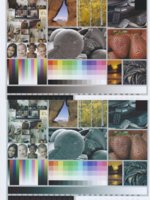- Thread starter
- #51
arw4
Fan of Printing
- Joined
- Sep 20, 2006
- Messages
- 75
- Reaction score
- 27
- Points
- 73
- Location
- Surrey, England, UK
- Printer Model
- Canon MX925 plus a few others
I have to admit, neither of the scans I posted previously looked very good, you're right. Thank you for providing those test images. I've now had a chance to run the comparison test between IS inks and Canon. I've carefully followed your instructions and printed on glossy paper, keeping everything identical except for the inks of course. You'll have to remember that I am not in the realms of profiling, at least not yet. So no compensations are made. Oh, and the the printer is set to default, I did double check this. So, here are the results on the "glossy photo paper" setting:Just viewing your attached files, I reckon you have a serious problem with just about everything you print, and I wouldn’t recommend you get into diluting any of your inks either, the image you posted was a test image and its balls up completely, and/or your printer may need to be set to default again.
The images provided below will give you and us something to go on, so unzip and print on glossy paper, but don’t do anything else to it and upload the results, please give the print time to dry before scanning...
Sometimes there is a need to start from the beginning...
The Canon OEM inks are used on the image (top) in both cases. IS inks are used on the image (bottom) - how apt!
Attachments
Last edited:


